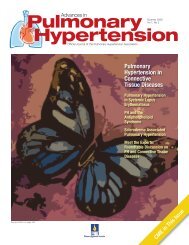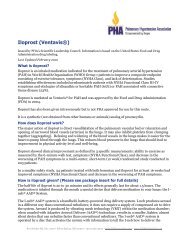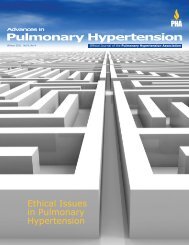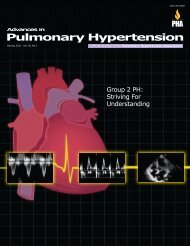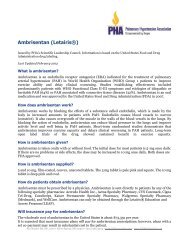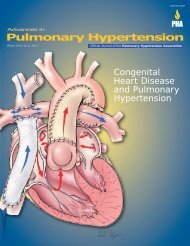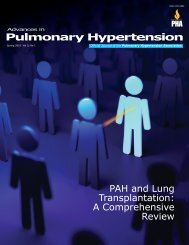Vol 7, No 3 - PHA Online University
Vol 7, No 3 - PHA Online University
Vol 7, No 3 - PHA Online University
You also want an ePaper? Increase the reach of your titles
YUMPU automatically turns print PDFs into web optimized ePapers that Google loves.
a<br />
Figure. (a) Schematic showing the measurement of augmentation index using the pulmonary arterial waveform.<br />
This augmentation index (∆P/PAPP) relates the change in pressure (∆P) to the pulmonary arterial pulse pressure<br />
(PAPP) and gives an estimation of pulmonary vascular stiffness. (b) Schematic showing a sample RV pressure<br />
volume loop relationship including effective arterial elastance (Ea), end-systolic pressure volume relation (ESPVR),<br />
and end diastolic pressure volume loop relationship (EDPVR).<br />
load vary from study to study, and maximal workload exercise has<br />
been tested in few subjects, the main goal of exercise is to increase<br />
heart rate to 85% maximal age-predicted heart rate as is<br />
used in cardiology stress testing. Given increased thoracic pressure<br />
changes with exercise, particularly in overweight and/or deconditioned<br />
patients, it is critical that measurements be made at<br />
end-expiration to ensure uniformity in interpretation.<br />
An increase in PCWP to greater than 15 mmHg in response to<br />
exercise or fluid challenge suggests the presence of pulmonary<br />
venous hypertension, a condition with dramatically different management<br />
than PAH. Because cardiac output can increase up to 5-<br />
fold above baseline, pulmonary vascular resistance (PVR) normally<br />
decreases with exercise. 8,9 Poor prognostic signs in exercise right<br />
heart catheterization are: (1) the inability of the right ventricle<br />
(RV) to augment in response to exercise, ie, lack of a significant<br />
increase in cardiac output; (2) angina; and (3) presyncopal symptoms<br />
or frank syncope.<br />
<strong>No</strong>vel Hemodynamic Techniques<br />
Assessment of the pulmonary arterial pressure waveform. Chronic<br />
pulmonary hypertension results from an increase in pulmonary<br />
vascular resistance, which is a simple measure of the opposition<br />
to the mean component of flow. However, given the low resistance/high<br />
compliance nature of the pulmonary circulation, the<br />
pulsatile component of hydraulic load is also critical to consider.<br />
The fact that the mean and the pulsatile components of flow are<br />
dependent on different portions of the pulmonary circulation suggests<br />
that they can be controlled separately, without much overlap.<br />
The pulmonary circulation is pulsatile with multiple bifurcations;<br />
and wave reflection is an inevitable consequence. When the<br />
forward pressure wave from the heart collides with the backward<br />
pressure wave that was reflected from the bifurcations, pressure<br />
increases and flow decreases. Because the often used PVR only<br />
takes into account mean flow, it does not allow for changes in<br />
pulsatility of the pulmonary circuit. 11-14 One must consider the<br />
elastic properties of the pulmonary circulation and impedance on<br />
RV performance rather than the pure resistive properties since the<br />
heart could not function if it were not for the elastic properties of<br />
b<br />
pulmonary vasculature. During<br />
systole, the pulmonic valve is<br />
open at a time when the mitral<br />
valve is closed. Thus, if it were<br />
not for the elastic properties of<br />
the pulmonary vasculature, the<br />
heart could not develop forward<br />
flow. 12-14<br />
Pulse pressure indicates the<br />
amplitude of pulsatile stress.<br />
Pulse pressure is mainly determined<br />
by both the characteristics<br />
of ventricular ejection and arterial<br />
compliance, so that the lower<br />
the compliance, the higher the<br />
pulse pressure. Moreover, pressure<br />
waveform analysis performed<br />
in the time-domain makes<br />
it possible to calculate the timing<br />
and extent of wave reflection<br />
in systemic and pulmonary circulation<br />
using measures such as<br />
augmentation index (as shown in the Figure) which roughly represents<br />
reflected wave summation (∆P) in the pulmonary circuit<br />
and normalizes for pulmonary arterial pulse pressure. 15-23<br />
These values can be easily obtained at the time of right heart<br />
catheterization and the future studies will compare both analyses<br />
as potential prognostic indicators in patients with pulmonary hypertension.<br />
24<br />
Right ventricular pressure volume loop relations. The use of<br />
pressure-volume (PV) loop analysis as a means of measuring loadindependent<br />
contractility has largely been restricted to the study<br />
of LV hemodynamics and the interaction between the LV and the<br />
systemic vasculature. 21,25-36 This has primarily been due to geometric<br />
differences between the 2 ventricles and the optimal conductance<br />
properties required for proper volume measurements<br />
and the belief that it is difficult to obtain consistent data using<br />
conductance measurements in the crescent-shaped RV.<br />
Under conditions of normal PAP and RV function, an analysis<br />
of the RV PV loop is somewhat complicated given the crescent<br />
shape of the normal RV (Figure) and the ellipsoid shape of the PV<br />
loop obtained under these conditions. However, under conditions<br />
of even only modestly increased load, the RV changes shape to<br />
one resembling the more spherical LV and allows for measurement<br />
of end-systolic elastance (Ees) and effective arterial elastance<br />
(Ea) as well as the more accurate measurements of indices<br />
of RV systolic and diastolic function as well as RV/PA coupling<br />
(Figure).<br />
The performance of such studies is relatively easy and can be<br />
made in the same acquisition time as making measurements<br />
using FDA-approved equipment. Essentially, all of the currently<br />
used PAH therapies, particularly the phosphodiesterase inhibitors<br />
and endothelin receptor antagonists as well as many of the emerging<br />
experimental therapies (eg, imatinib) have primary—positive<br />
or negative—effects on the myocardium. 37-44 Thus, a study of the<br />
intrinsic contractility of the RV is perhaps the only reliable way to<br />
separate the effects of these therapies on pulmonary arterial systolic<br />
pressure versus the RV myocardium. In that sense, studies<br />
of the RV contractility are not only relevant to the clinical management<br />
of PAH patients but critical for the interpretation of data<br />
from clinical trials as well.<br />
344 Advances in Pulmonary Hypertension



